Microsoft just rolled a new revamped Snipping Tool that replaces both the classic Snipping Tool and the Snip & Sketch apps in Windows 11. These two legacy apps were not entirely removed but instead, the best features of both apps were combined into a unified brand new Snipping Tool with some added functionalities.
Snipping Tool is a Windows screenshot utility that lets you take screenshots or snapshots of the entire screen, windows, or a particular area on your display. Capturing a screenshot is the quickest and easiest way to capture exactly what your screen is displaying in a picture format so you can share it with others or save it for future reference.
You can use the Snipping Tool to capture the screenshots of a particular window, a rectangular area, a free-form area, or the full screen. It also provides options to set a timer (in secs) to take screenshots. In addition, the new app provides new and improved editing tools as well as a new settings page to configure the app. In this tutorial, we will show you everything about how to use the New Snipping Tool in Windows 11.
How to Take Screenshots with Snipping Tool in Windows 11Screenshots are really useful when you want to share important information (like system configurations), troubleshooting an issue, use them for projects and assignments, post it on Facebook, explain a process in an article like this one, and much more. Windows 11’s new built-in Snipping Tool provides various snipping modes and richer editing options which makes taking screenshots a smooth and comfortable experience. Let us see how to take screenshots (snips) using the Snipping Tool in Windows 11.
Launching Snipping tool with Keyboard ShortcutThe fastest and easiest way to capture a screenshot (snip) in Windows 11 with the snipping tool is by pressing the keyboard shortcut Window Logo Key+Shift+S. Once you press the shortcut keys, you would see the four snipping modes/options at the top of your screen as shown below.

Select the snipping mode you want to use to take a screenshot, including:
Rectangular Snip – This mode allows you to take a screenshot of a rectangle area of the screen. Select this option and simply click and drag a rectangular area of the screen you want to snip.Freeform Snip – This mode allows you to take a screenshot of the area in free-form. Select this mode to custom draw around the object you want to snip.Window Snip – Select this mode helps you capture the screenshot of a particular app window on the screen.Fullscreen Snip – This mode enables you to capture the entire screen of the display.If you select ‘Retangular snip’ or ‘Freeform snip’, simply click and drag the area of the screen you want to snip. If you select ‘Window snip’ mode, select any window on the screen to take a snip. For ‘Fullscreen snip’, simply selecting this option will take the fullscreen screenshot.
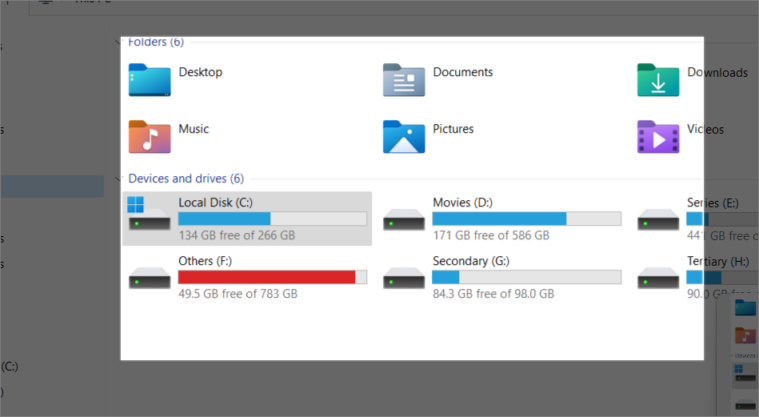
And if you want to cancel the snipping process, click the ‘X’ icon at the last of tools or press Esc.
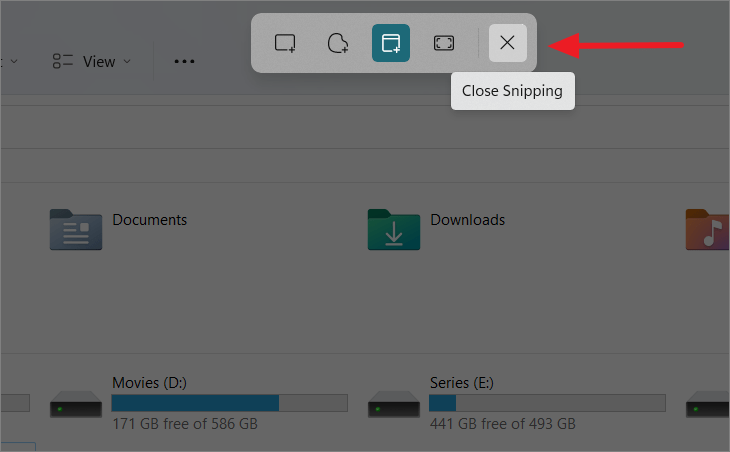
Once you take the screenshot, a notification will appear at the bottom-right corner of the screen. Click on the notification to open the screenshot in the Snipping Tool window.
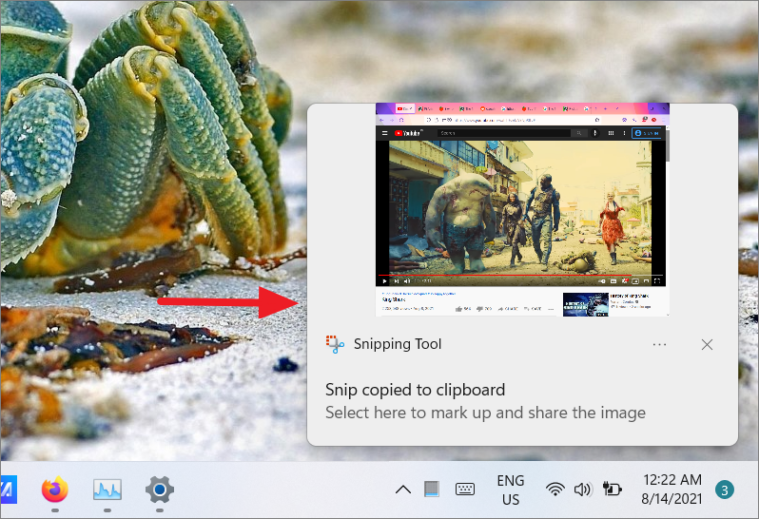
Also when snipping a screenshot, the image is automatically copied to the clipboard, so you can directly paste the screenshot into websites, photo editing tools, or other apps.
When you click the notification, it will open the snapshot in a new Snipping Tool window as shown below. Here, you will find various options and tools to edit, annotate, save, share, and print the screenshot. For example, we have taken a screenshot of a YouTube video below.
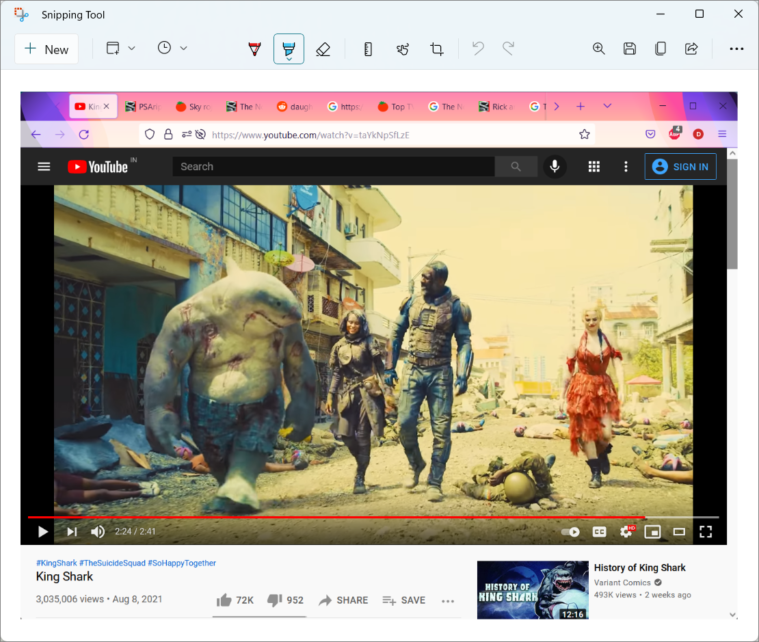 Launching Snipping Tool from the GUI options
Launching Snipping Tool from the GUI options Another way to take a screenshot with the Snipping tool is by launching the app first and using the options to snip a screen.
To launch the Snipping Tool app, search for ‘Snipping Tool’ in the Windows Search and select the relevant search result.
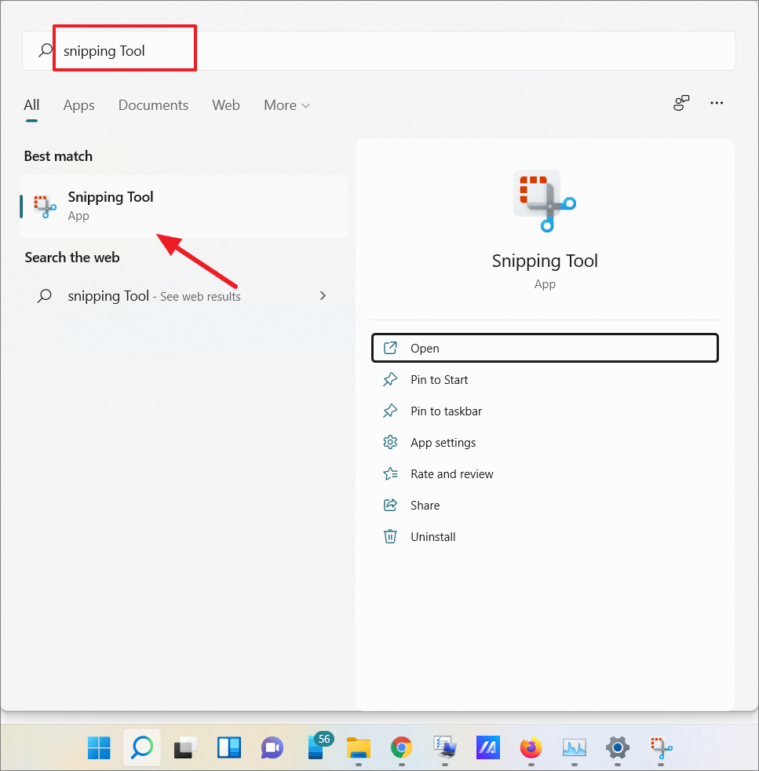
The Snipping Tool will appear based on the Windows Theme. To snip a screen, simply click on the ‘Snipping Mode’ drop-down menu and select one of the four-mode. Then, click the ‘New’ button to take the screenshot in the selected mode.
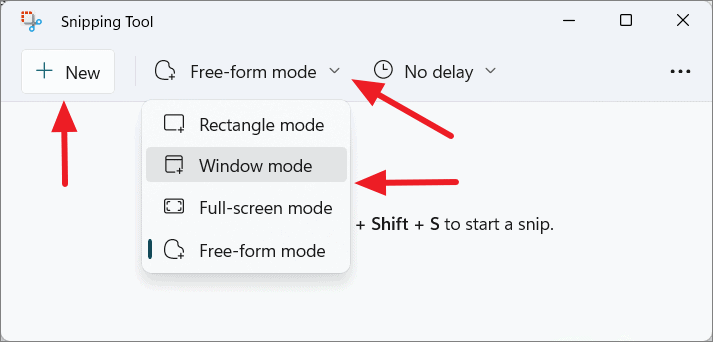 Delay the Snipping Time
Delay the Snipping TimeIn the app, you also have options to delay the snipping time. This can be used to take a screenshot after 3, 5, or 10 seconds after clicking the ‘New’ button. This is useful if you want to snip pop-up windows, progress status, or messages.
First, select the mode, then click on the ‘Time before snip’ drop-down option (which is set to ‘No delay’, by default), and select the period after which you want to take the screenshot. You have only three pre-defined time delays: ‘Snip in 3 secs’, ‘Snip in 5 secs’, or ‘Snip in 10 secs.
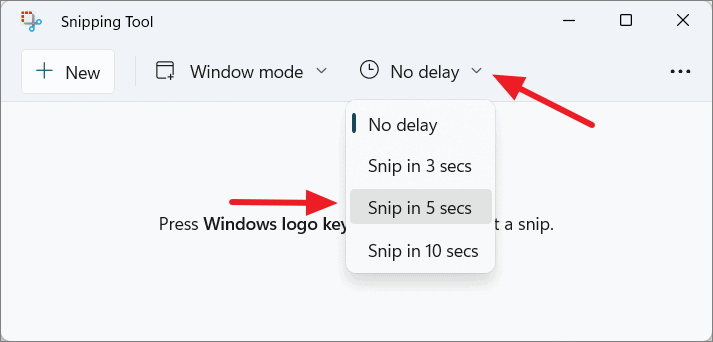
You should know that delay snipping is not available for Fullscreen mode.
How to Save, Share, Copy and Print the ScreenshotsWe’ll see how to annotate and edit your screenshots, in detail later, but first, let’s see how to zoom, save, copy, share and print your snips in the Snipping Tool.
You can find the zoom, save, copy, and share options (as icons) in the top-right corner of the toolbar.
Zooming into the screenshot. To zoom into the image, click the ‘Zoom’ icon, and use the slider to zoom in and out on the image.
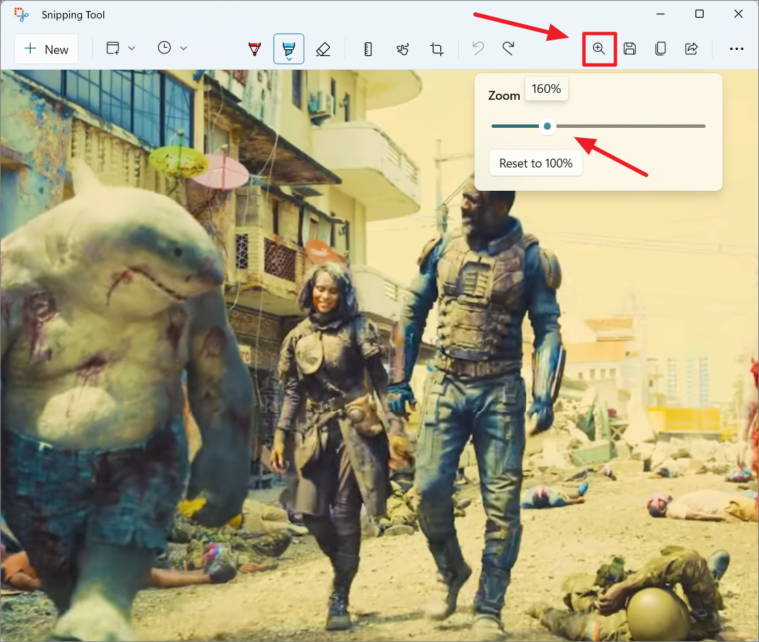
Saving your screenshot. You can save the screenshot in JPEG, PNG, or other formats. To save a screenshot (snipping), click the ‘Save as’ icon or press Ctrl+S.
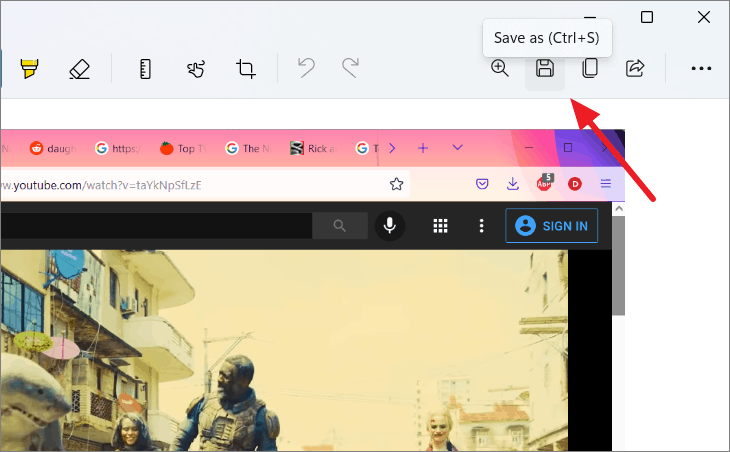
Name the file in the Save As window, choose a format, and select a location to save the snipping.
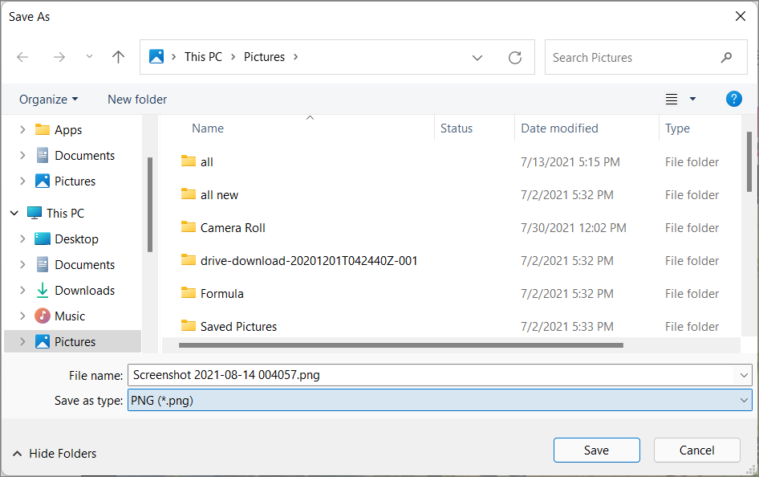
Copy screenshot to clipboard. When you take the snip, your screenshot is copied to the clipboard automatically, but if you want to copy the annotated and edited screenshot to the clipboard, click the ‘Copy’ icon next to the Save icon or press Ctrl+C.
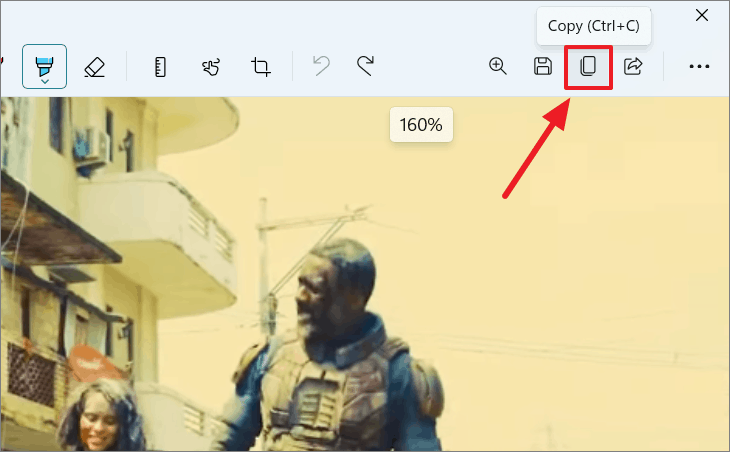
Sharing the screenshot using Windows 11 Share menu. To share the screenshot or image with someone else, click/tap the ‘Share’ icon and choose whether you want to share the image by e-mail, Bluetooth/Wi-Fi, or any other displayed application.

Printing the screenshot. You can even print the screenshot by clicking the three-dot menu button on the top right corner of the app and selecting the ‘Print’ option. Then, you can choose the printer connected to your device to print the image.
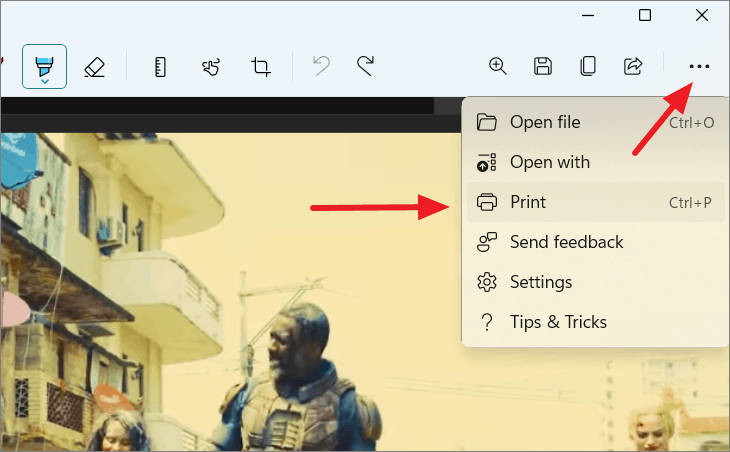 How to Edit a Screenshot in Snipping Tool
How to Edit a Screenshot in Snipping ToolOnce you capture the screenshot, the editing tools in the app let you annotate and edit your screenshots. The Snipping Tool provides you with various editing tools, including a Ballpoint pen, Highlighter. Touch Writing, Eraser, Protractor, Ruler, and Image cropping.
 Annotating Screenshots in the Snipping Tool
Annotating Screenshots in the Snipping ToolYou can write, draw or highlight on the screenshot by selecting the ‘Ballpoint Pen’ or the ‘Highlighter option’. Double-click on either of the icon to open the color palette and choose the color and size of the pen or highlighter.

Then, you can draw, write, and highlight using the tools on the snip.
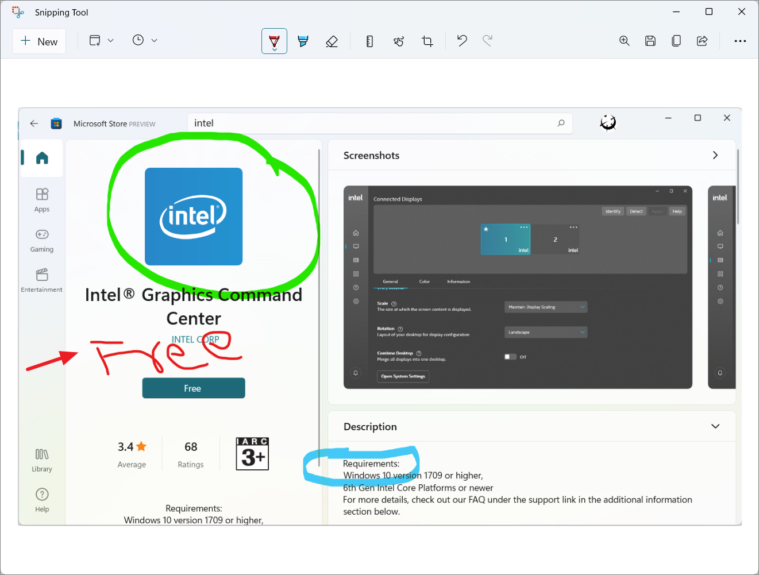
You can also use these tools by pressing Alt+B for Ballpoint pen and Alt+H for highlighter.
Erasing Annotations in Screenshots in the Snipping ToolEraser tool can be used to delete annotations or drawings from the snip. Click on the ‘Eraser’ icon, and then drag the cursor on the specific strokes or writings you want to erase.

To delete all the annotations on the snip, double-click on the ‘Eraser’ icon, and select the ‘Erase all ink’ option.
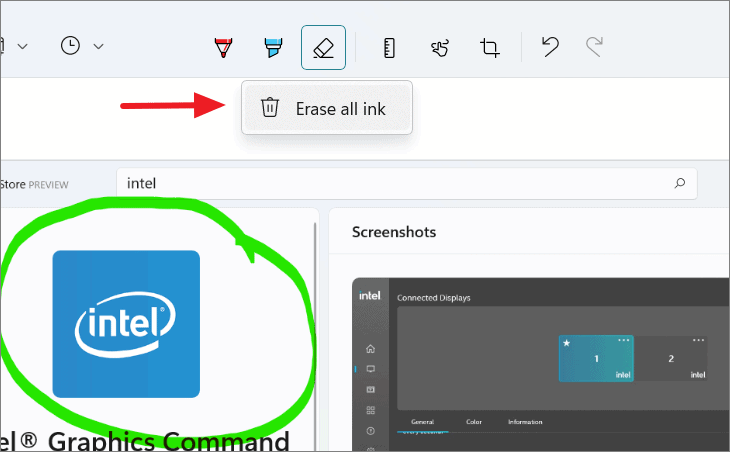 Using the Ruler and Protractor in the Snipping Tool
Using the Ruler and Protractor in the Snipping ToolThe snipping tool also includes a Ruler and a Protractor, which can help you draw straight lines or arches. To access the ruler, click or tap the ‘Ruler’ button or double-click on the Ruler icon from the top toolbar and select ‘Ruler’.
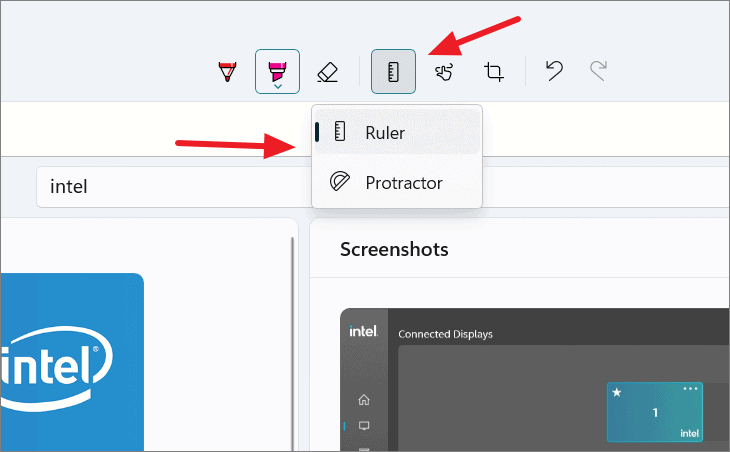
The virtual ruler will appear in the middle of the Snipping window as shown below. To move the ruler, just click/ tap on the ruler and drag the ruler across the image using your finger, mouse, or pen. You can then use the ruler to draw straight lines or measure something.
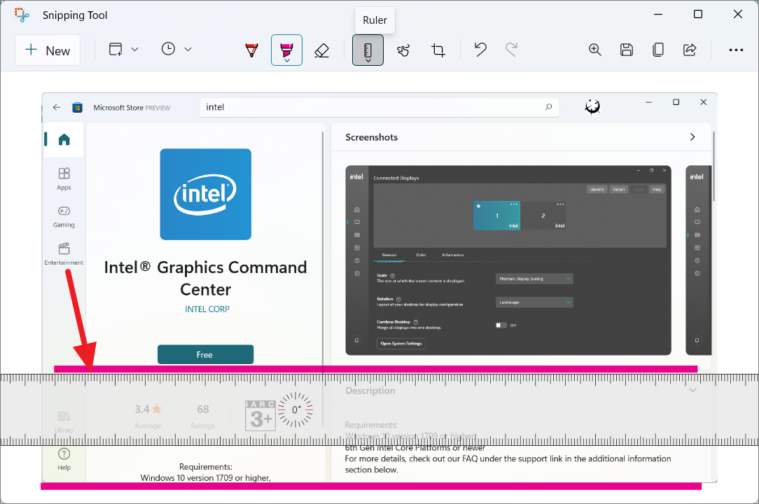
Moreover, if you wish to rotate the ruler, just hover your mouse over the degree number (which is 0° by default) in the middle of the ruler and use the mouse scroll wheel or use two fingers to rotate the ruler.
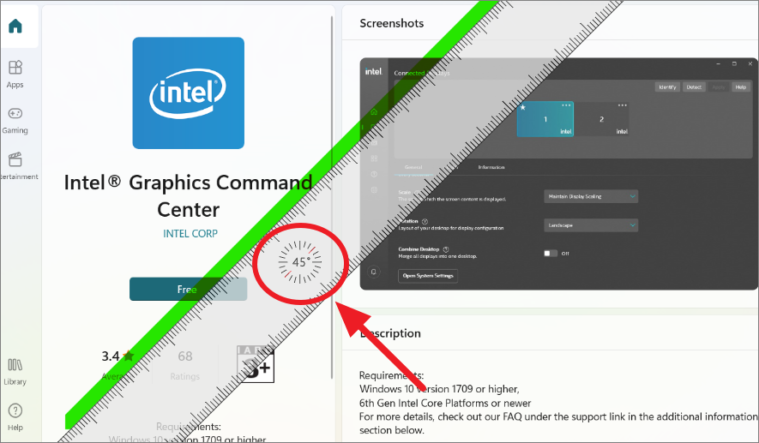
To remove the ruler, click/tap on the ‘Ruler’ icon from the toolbar and select ‘Ruler’ again.
To access the Protractor, click or tap the ‘Ruler’ icon or double-click on the Ruler icon and select ‘Protractor’.
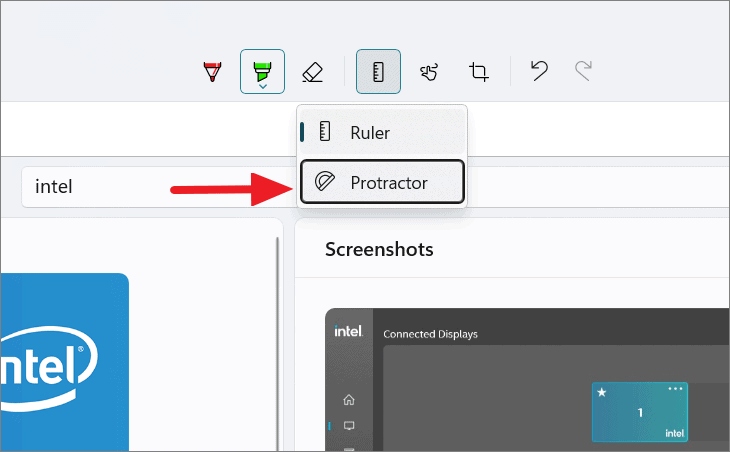
Then, you can use the virtual protractor to draw an arc/pie from a certain angle or measure angles as shown below. Click or tap on the protractor and drag to move the protractor where you want it. You can resize the protractor by scrolling the mouse scroll wheel on top of the protractor or use two of your fingers to make it smaller or bigger.
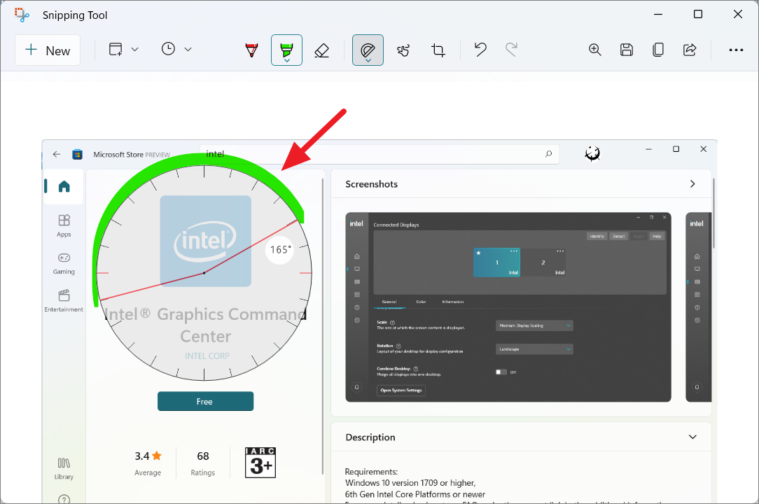 Touch writing in the Snipping Tool
Touch writing in the Snipping ToolAnother useful tool you have here is Touch writing. You can write anything you want on the snip by clicking or tapping on the ‘Touch Writing’ icon on the toolbar and use touch to write on your screenshot. This tool works best if you have a tablet or 2-in-1 device with touch screen support, but if you don’t have a touch screen then you can also use the mouse cursor to write. You can also toggle this tool by pressing Alt+T.
 Cropping Screenshots or Images in the Snipping Tool
Cropping Screenshots or Images in the Snipping ToolIf you want to crop a screenshot or image, click or tap the ‘Crop’ icon from the toolbar.
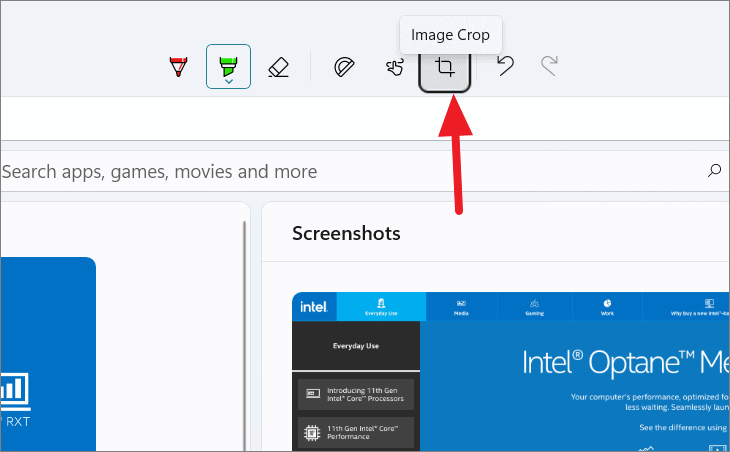
Then, drag the white corners shown on the screenshot to select the area that you want to crop. When you are done, click the ‘Apply’ button (tick mark) on the top or press Enter. If you want to cancel the crop, click the ‘Cancel’ button (X) or press Esc. You can also zoom in or out in the screenshot using the ‘Zoom’ button next to the Apply button.
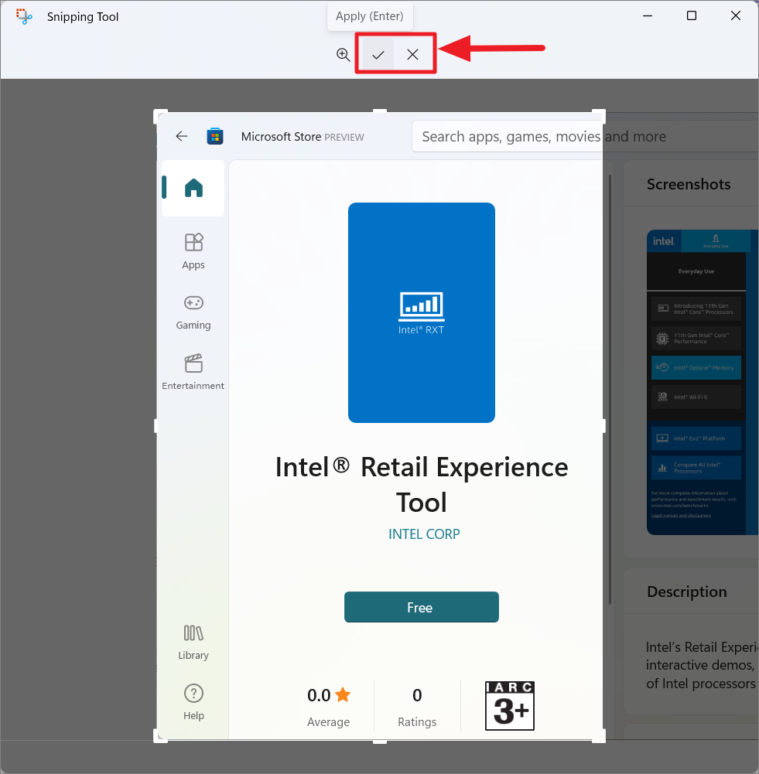 Undoing/ Redoing the Edits in the Snipping Tool
Undoing/ Redoing the Edits in the Snipping ToolYou can undo the edits you made on the screenshot or image by clicking on the ‘Anticlockwise arrow’ on the menu bar or by pressing Ctrl+Z on the keyboard.
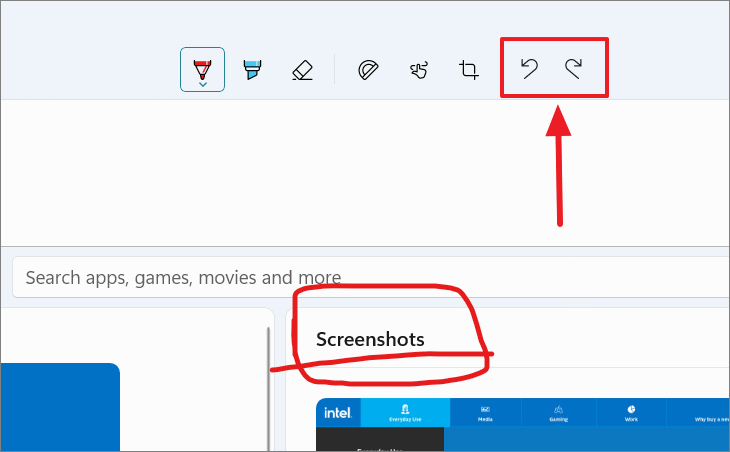
You can also redo the changes you made on the snip by clicking on the ‘Clockwise arrow’ on the toolbar or pressing Ctrl+Y.
Setting Up the Snipping Tool in Windows 11The snipping tool comes with a new separate Settings page, where you can customize the app preferences such as opening each screenshot in a new window, automatically adding outlines, etc. One of these options is setting the PrtScn key to open the snipping tool.
Enable Print Screen Key to Launch the Snipping ToolTo quickly take a screenshot with Snipping Tool, you have to press Win +Shift+S, but it may take a few seconds to press all three keys at once on the keyboard. However, you can also capture a screenshot by simply pressing the PrtScn (Print Screen) key alone, which can make screen snipping easier and faster than the above three keys shortcut.
To open screen snipping with the PrtScn key, first, you need to enable this shortcut in Windows Settings. Here’s how you can do this:
First, open the Snipping Tool, click the three-dot menu button at the top-right corner of the app, and select ‘Settings’ in the menu.
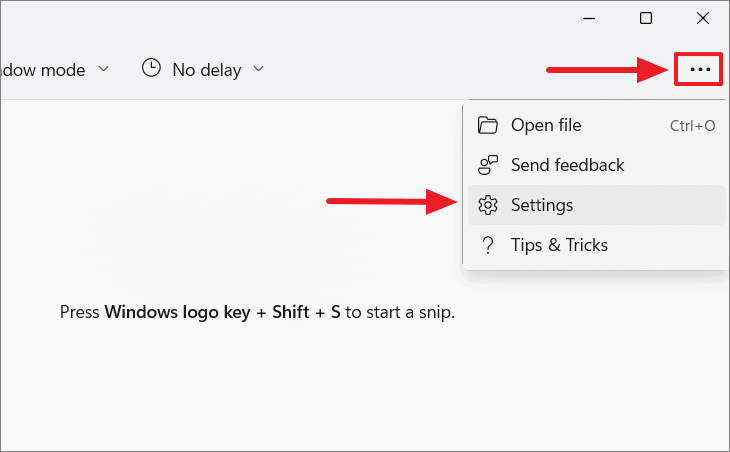
In the Snipping Tool Settings page, click the ‘Change in settings’ button under the Shortcuts section.

It will ask you for confirmation to switch apps, select ‘Yes’ in the dialog box.
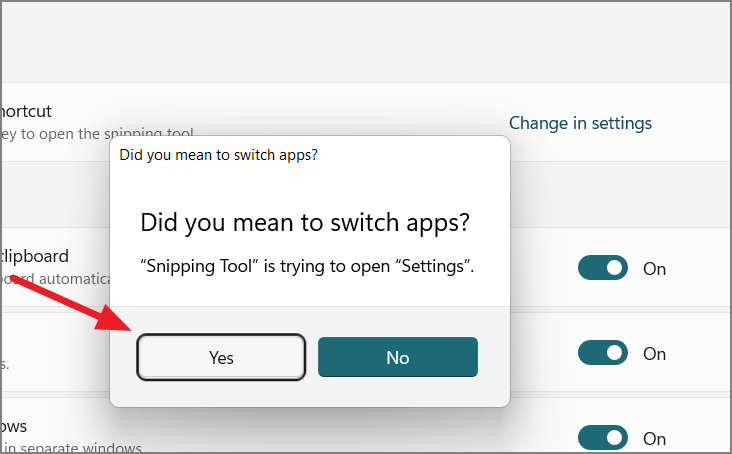
This will open Windows 11 Keyboard Settings page under Accessibility. Scroll down the Keyboard settings page until you reach the option to enable the Print screen shortcut, which is located under the ‘On-screen keyboard, access keys, and Print Screen’ section.
Then, click on the toggle next to ‘Use the Print screen button to open screen snipping’ to enable the shortcut as shown below. After completing the steps, you might need to restart your PC to apply this change.
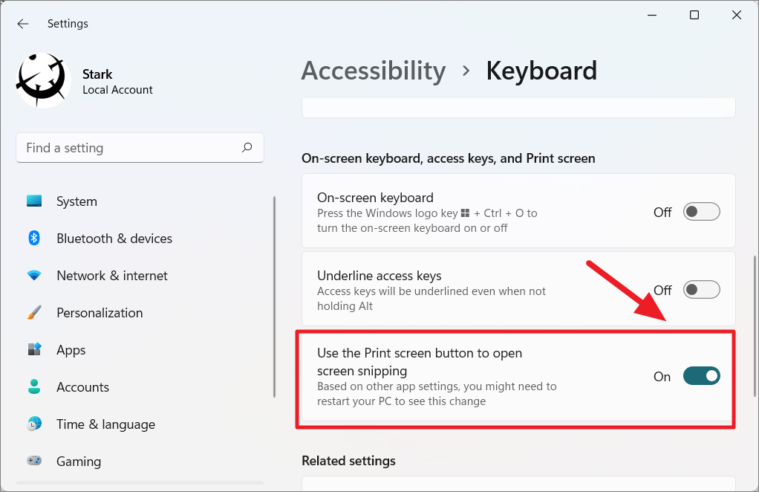
Once you restart your PC, simply hitting the PrtScn key on your keyboard will open the screen snipping options on top of the screen to take a snip.
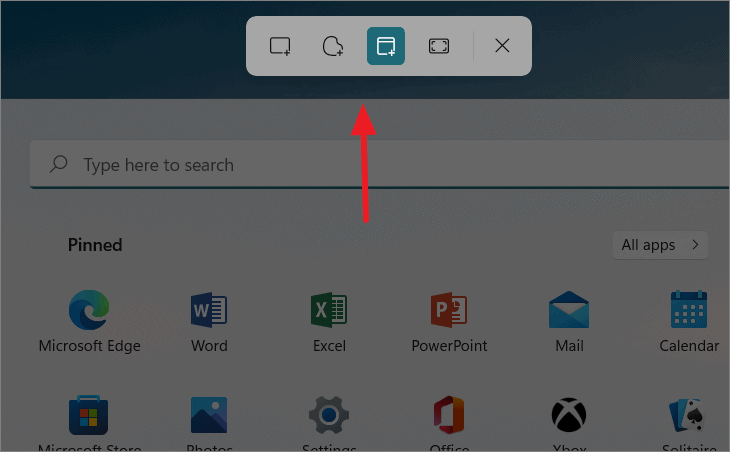 Snipping Settings
Snipping SettingsYou also have various other snipping settings on the Settings page to customize your snipping experience.
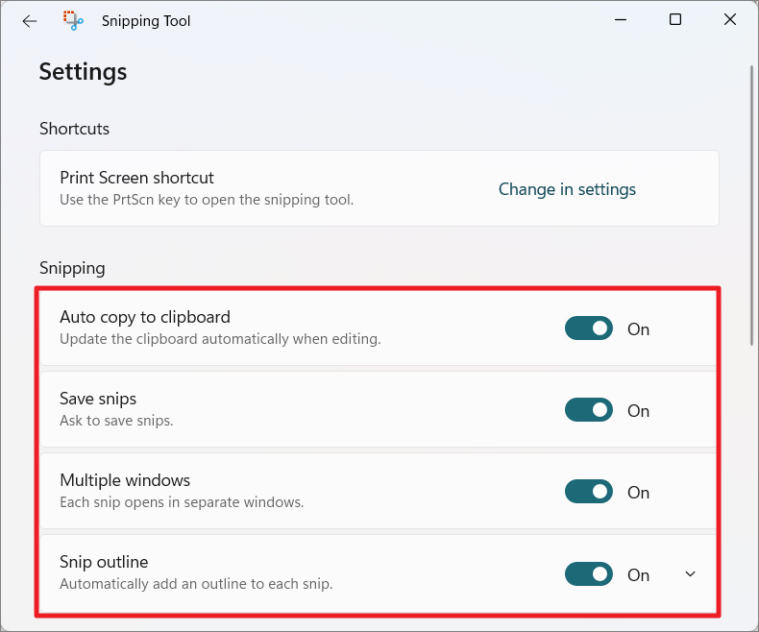
These options are pretty much self-explanatory. These include,
Auto copy to clipboard – Enabling this option will auto-update the clipboard as you make changes to the screenshot.Save snips – Turning on this toggle will ask you to save the screenshot before closing the snipping tool.Multiple windows – This setting allows you to open each new snip in a new separate window.Snip outline – Enabling this option will automatically add an outline to each screenshot. You can even customize the color and size of the outline by clicking the downward arrow button next to the Snip outline toggle.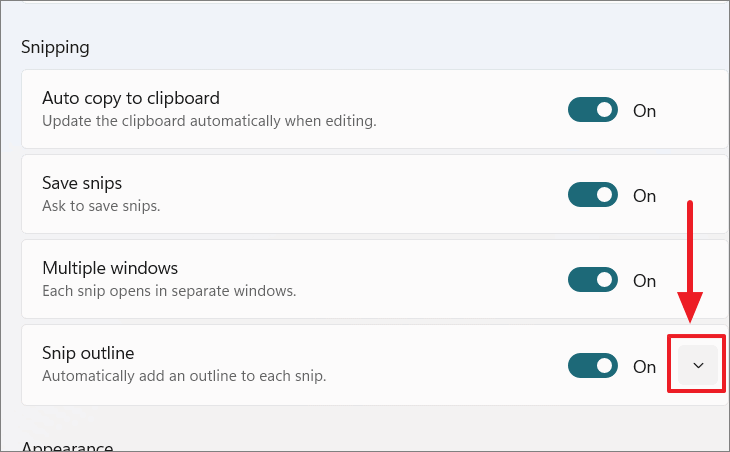
When you click the downward arrow, you will see the Color and Thickness options as shown below. Click on the color box to choose your desired color from the color palette and use the slider to adjust the thickness of the outline.
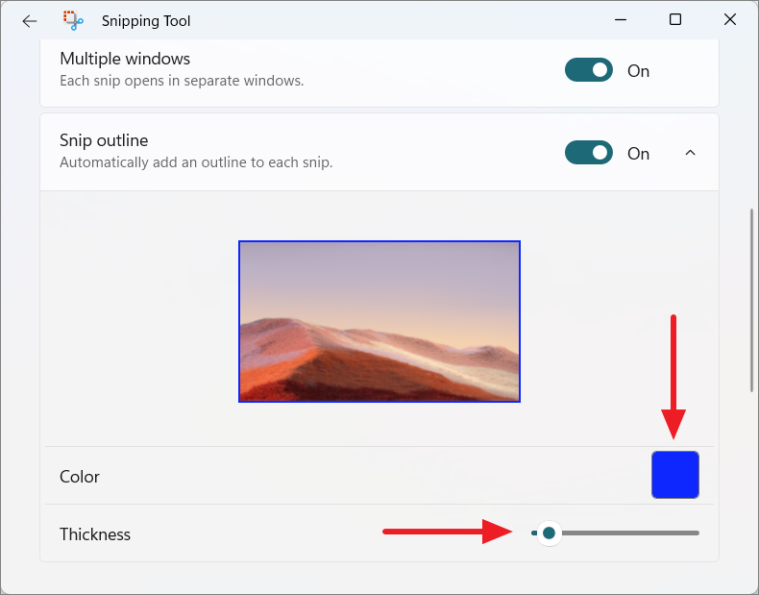 Change Snipping Tool Theme to Dark or Light mode
Change Snipping Tool Theme to Dark or Light modeThe Snipping Tool also allows you to set the theme of the app independent from the Windows theme using the Settings page. To change the theme of the snipping tool, click the ‘App Theme’ drop-down under the Appearance section.
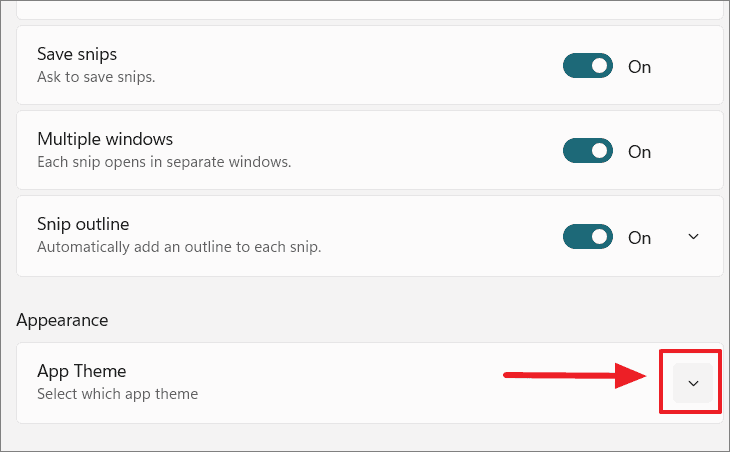
By default, it is set to use the Window’s theme. If your system uses a dark theme, the app will also appear in dark mode. But, you can choose between ‘Light’ and ‘Dark’ mode as well as the ‘system setting’ (Windows theme).
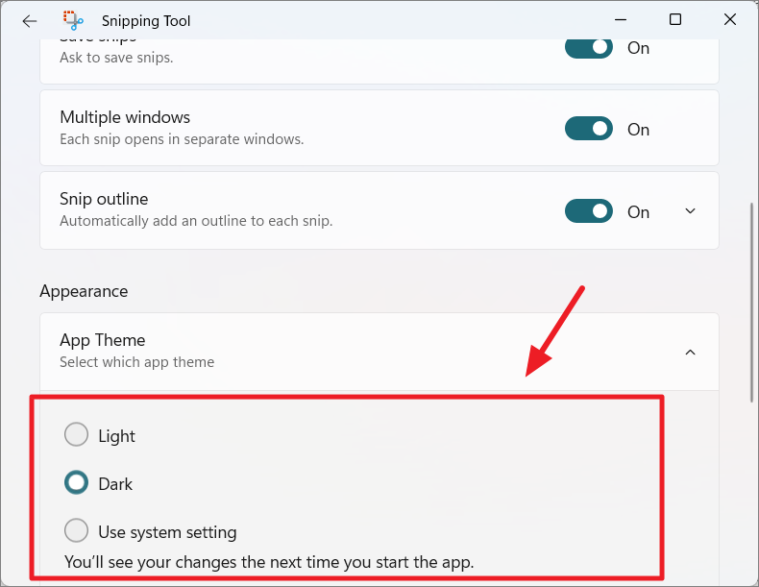
Once you change the theme, you’ll need to restart the app to see the changes.
That’s it.
The link has been copied!